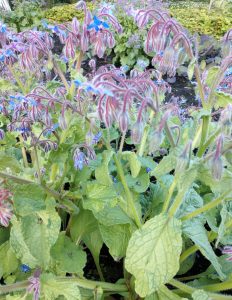
Linda Akiyama works valiantly to keep up with her sizable home garden in Thurston County. “One thing leads to another,” she muses. Her rows of vegetables, mini-orchard and various fruit vines and canes are arranged throughout a half acre, which basically produces an abundance of food for their two-person household. Linda could do garden-related work all day every day. There’s weeding, watering, thinning, pruning, harvesting and, when she remembers, admiring. Although garden activities tire to the bone, her joy of reaping fresh vegetables and serving them at meals with her husband, Paul, clearly tips the scales to keeping it going. “It would be very hard to go back to not having it,” she says.
 “I have always loved gardening,” Linda continues, smiling as she recalled childhood time spent with Grandma in her garden. They ate what they grew. Her parents also kept a garden. In the college days at Washington State University (WSU), she cultivated a space in the community garden. She remembers it was great because they provided the space and the water. After college, her gardening languished, but not her dreams.
“I have always loved gardening,” Linda continues, smiling as she recalled childhood time spent with Grandma in her garden. They ate what they grew. Her parents also kept a garden. In the college days at Washington State University (WSU), she cultivated a space in the community garden. She remembers it was great because they provided the space and the water. After college, her gardening languished, but not her dreams.
Their move three years ago from University Place to Olympia allowed them add garden space to their list of property requirements. A house with gorgeous waterfront turned up. It was in serious need of Paul’s architectural skills, but there was a significant plot for planting. It was in need of serious clean-up, but they were up for the challenge.

It’s easy to get excited about a new garden. Heed this excellent advice: Plan before planting. Linda recommended visiting the Territorial Seed Company website. As you would expect, Territorial Seed has all sorts of vegetables, fruits and supplies, but there’s much more. You can utilize their garden planner to maximize your space and also avoid wasted space. That means you learn the timing of crops so that as one finishes you are ready to put in the next round of something else.
Linda continues to learn as she goes along. Initially the soil was poor and consequently produced poor results. As they have improved the soil, the produce has grown better. She looks for ways to reduce the ever-present weeds and pests. Last year she seeded for borage. This season numerous volunteers sprouted, which was excellent. Borage repels tomato hornworms and cabbage worms. The purple/blue blossoms attract bees, which is good for all of us. The plant also adds trace elements back into the soil.
Another source of education and support is the Facebook group called Back to Eden Gardening. Linda has been inspired with their use of wood chips to keep down weeds and reduce watering needs. She plans to do more of this throughout her garden. You can learn more about how this process can work for your garden by watching the film.
Are you wondering what Linda is growing? It’s an impressive list: carrots, asparagus, horseradish (one plant), borage, garlic, rhubarb, purple sprouting broccoli and cauliflower, kohlrabi, cabbage, artichokes, lettuce, beets and radishes. She has zucchini, butternut and delicata squash, and cucumbers. You will find four varietal apple trees, and one of each of Italian plum, pear, apricot and fig. There are strawberries, blueberries, raspberries and kiwi vines. “I didn’t have to buy vegetables all winter,” she reported, which is pretty amazing. Much of the garden gets picked through the winter. For example, carrots stay in the ground for storage. Some produce ripens during our winter such as brussels sprouts at Christmas time. Purple broccoli and cauliflower grow in February and March.

What happens to all the food? There is a lot of fruit dehydrating going on at the Akiyama house. Linda does not do much canning, but she does put some into the freezer. Some of the vegetables get fermented. Beets are one of their favorites.
Linda encourages you to plant what you like to eat. She likes spinach but didn’t plant it this time because it bolts (goes to seed) quickly. When she really wants some spinach, she’s willing to buy it from someone else. This year she didn’t plant kale because she didn’t like it cooked. I’ll add there are many types of kale, so I’d encourage planting more than one to see if you can find one you do like.
Finally, it’s fine to start small with your garden. It could be a pot or two with herbs and cherry tomatoes. Those are easy to manage. The taste of just-picked vegetables has no comparison. It really is fun and fresh to have your own source. Eastside Urban Farm & Garden Center is a splendid local resource. Happy Growing!


















































